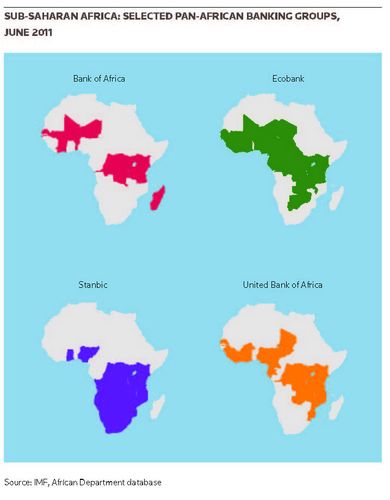African banks, like Gaul, fall into three categories. The first are national institutions, the second, pan-African institutions and the third global institutions. Banks moving up this chain now challenge the largest South African banks for primacy in Africa.
To view the Digital edition, please click here.
The first among these is Ecobank, the Togan institution that leads the field in cross-border banking.
Arnold Ecpe, CEO of Ecobank, said: “The key challenges we face are the poor infrastructure that results in high operating costs and exchange controls, which inhibit trade and investments. Other factors such as different regulatory, legal, political and currency regimes are factors we have learnt to live with and which may sometimes have a positive effect in serving as barriers to entry by our competitors.
“The growing sophistication of domestic banks is clearly something we have to contend with. We have been able to differentiate ourselves through the broader range of products we provide such as Rapidtransfer, a money remittance product, and the Diaspora account for African expatriates, and also our increasingly sophisticated technology platform.”
Ecpe said that the most promising markets for Ecobank were the larger markets such as Nigeria, Ghana, Cote d’Ivoire, Senegal, Angola, Cameroon and Kenya. “There are also other very promising markets, but these are smaller in terms of their revenue pools.”
The pan-African institution is increasing in prominence in Africa, according to the IMF in its most recent report on Sub-Saharan Africa. It observed that over the past few years, pan-African banking groups have become systemically important for Sub-Saharan Africa. At least nine Sub-Saharan African financial groups operate banks in seven or more other African countries.
The Fund particularly drew attention to Ecobank, saying it has “the most widespread presence in Sub-Saharan Africa (in more than 30 of the 45 countries), and manages one of the five largest banks in at least 18 countries”.
Other institutions with this range include South African and Nigerian banking groups (most notably Standard Bank Group of South Africa and United Bank for Africa of Nigeria) have also aggressively expanded. The Bank of Africa, originally from Mali, operates in 11 Sub-Saharan African countries. The financial exposures involved are considerable.
The Fund observed: “Even with partial bank-level information, these groups manage more than 30% of deposits in 13 of the 45 Sub-Saharan African countries considered. The expansion of these banks has improved competition and given rise to economies of scale, because local markets are very small in some jurisdictions.”
The aggressive expansion of pan-African banking groups creates supervisory challenges, the fund continues, “especially on those banks incorporated in countries with weak consolidated supervision capacity”.
Deep experience
That said, Nigerian banking has a primacy in Africa by virtue of its scale but David Cowan of Citibank said senior management of the country’s institutions had deep international experience. He cites Zenith Bank and Guaranty Trust Bank as leaders in Nigeria.
In terms of bond issuance Guaranty Trust is a leader according to Segun Agbaje, the bank’s managing director. “GTB’s 2011 Eurobond offer was totally oversubscribed and was placed with over 30 accounts in Europe, United States, Asia and Africa.”
In 2007, the Bank pioneered the sourcing of funds by Nigerian banks from the international capital market. It issued a US$350m regulation S Eurobond; the first by any Nigerian bank and went on to undertake an US$824m global depositary receipt offer that same year. The listing of the GDRs on the London Stock Exchange made Guaranty Trust Bank the first Nigerian company and African bank to be listed on the main market of the London Bourse.
In December 2009, the bank completed the first tranche of a US$200m corporate bond and went on to issue a benchmark US$500m Eurobond to international investors in May 2011.
National banking stars may be found in many of the larger economies. The Angolan banking system, for example, is among the continent’s most dynamic, although among the commercial banks, three are foreign-owned and two are state banks, Banco de Poupanca e Credito and Banco de Comercio e Industria. The three larger banks (BPC, Banco de Fomento Angola and Banco Angolano de Investimentos) handle some 82% of the turnover of the entire system. However, the three private banks recently established (Banco Totta Angola, Banco Espirito Santo Angola and Banco Comercial Angolano) are the first to have offered banking products denominated in dollars, and have began to win a significant market share because of better quality service and a breakthrough in banking marketing. The state banks account for about 45% of commercial bank assets in the country.
Regulatory issues loom large for African banks and governments. In fact the system held up well during the financial crisis, although Nigerian banks took a considerable hit and this prompted a tough shake-out by Central Bank governor Lamido Sanusi, bringing 20 banks down to 15.
Evergreening
The IMF has reported in its most recent Regional Economic Outlook for Sub-Saharan Africa, that capital adequacy ratios for the largest 33 banks are more than twice the minimum 8% buffer set by Basel I. It commented, however, that “global financial distress very slightly increased non-performing loans and lowered profitability”.
It expressed some concern that capital buffers may not be as strong as they appear: “As a result of supervisory capacity constraints, and shortcomings in accounting and auditing practices, non-performing loans may not be recognised, leading to under-provisioning.”
Credit has expanded rapidly in many countries, from both domestic and, in more recent years, foreign banks, and the Fund says this makes it difficult to detect cases of “evergreening” of bad loans. The ability of some Sub-Saharan African banking systems to enforce financial contracts may be limited.
Although most Sub-Saharan African banking systems are relatively insulated from external financial volatility, it is possible that difficulties in some pan-African banks could spread throughout the region.
However, although Sub-Saharan Africa fares well compared with other regions in its implementation of the Basel I core principles, it faces two major supervisory weaknesses, according to the Fund. Consolidated banking supervision needs significant further development. In most countries, financial soundness indicators may say little about the true financial condition of a given entity or subsidiary because transfers of risky positions across balance sheets of conglomerate entities cannot be ruled out or effectively monitored.
The Fund also notes “problems of effective co-ordination between home and host supervisors, although in some cases efforts are under way to strengthen such co-ordination via the negotiation of memoranda of understanding between countries.
“Given these weaknesses, pan-African banking groups may be inadequately supervised, potentially giving rise to a possible channel of cross-country contagion,” said the Fund. It recommends country authorities monitor the placement of external assets to ensure that Sub-Saharan African commercial and central banks effectively implement risk management guidelines aimed at safeguarding continued liquidity and availability of these assets. “Regulators should consider the adequacy of ring-fencing arrangements for locally operating subsidiaries of international banks.”

